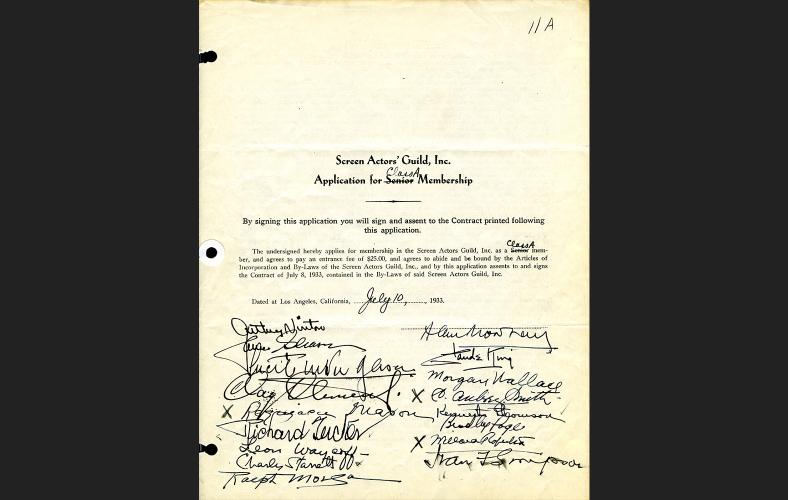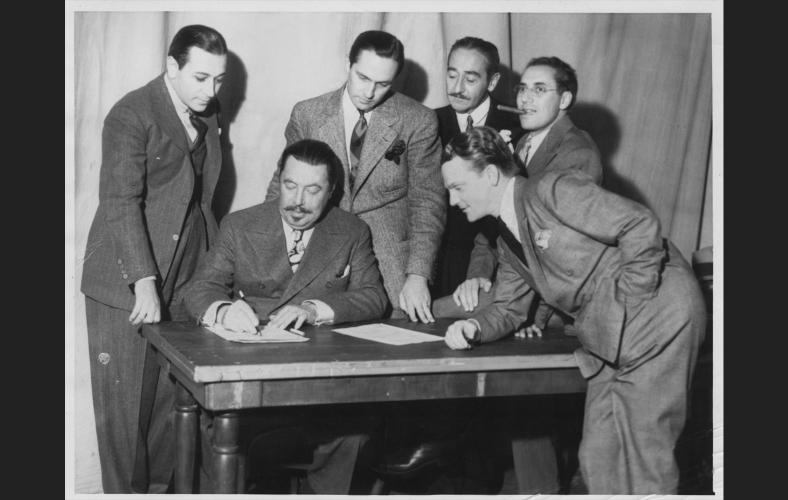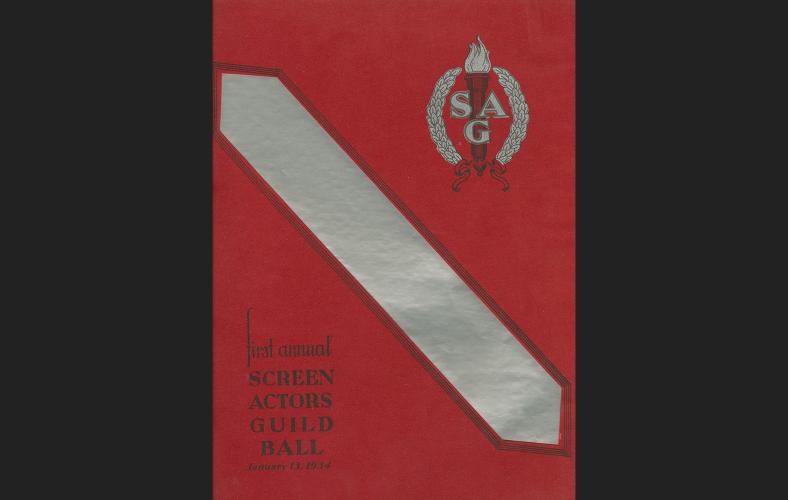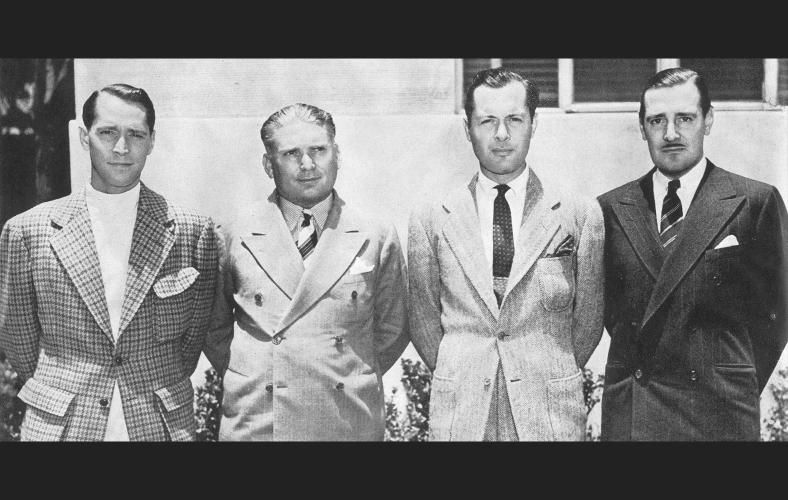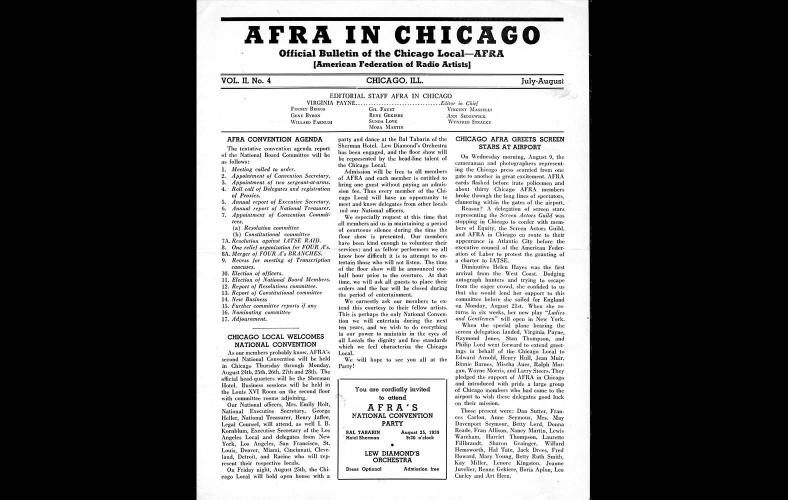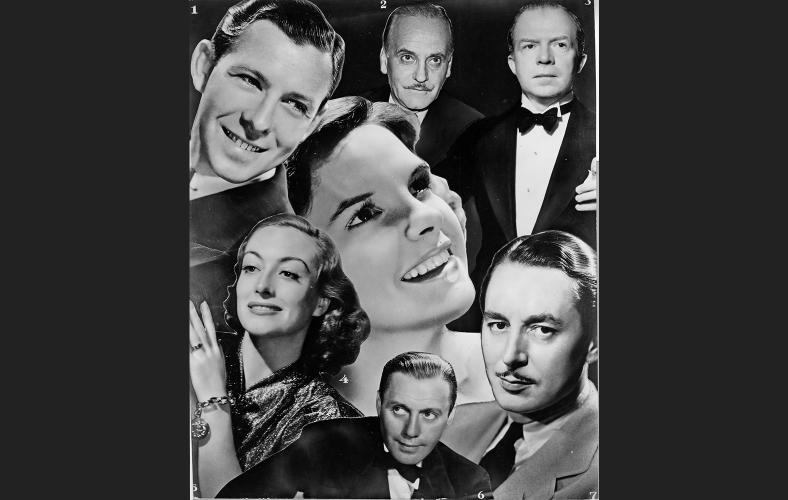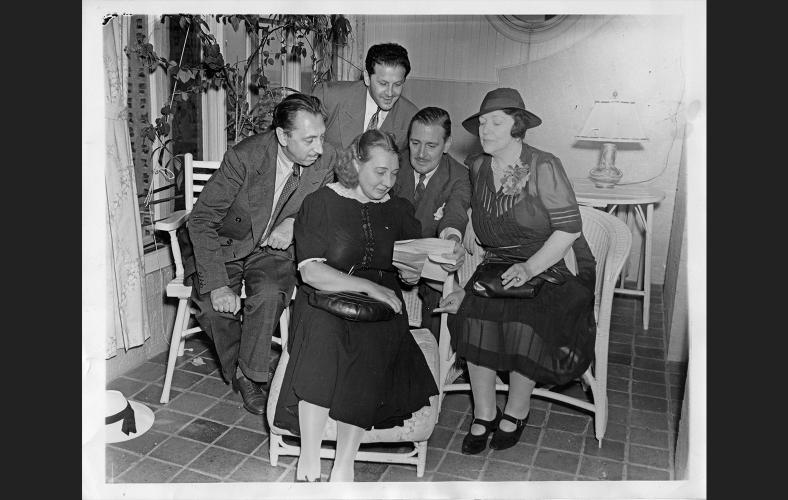The history of the unions during the 1930s.
1930
- Academy of Motion Picture Arts and Sciences adds 12-hour rest period to its contract for freelance film actors.
1931
- Great Depression increases its toll on the economy.
- Salary reductions in movie studios: "Efficiency experts" brought in by studios slash actors’ salaries by as much as 50 percent.
- Variety reduces cover price from 25 cents to 15 cents.
- Broadway and “the road” hurt by Depression. More stage actors come to Hollywood.
- Ralph Morgan arrives in Hollywood under contract to Fox Films.
- Boris Karloff experiences hellish 25-hour shoot on Frankenstein, and files complaint with Academy of Motion Picture Arts and Sciences.
1932
- Franklin Delano Roosevelt elected president
1933
- Screen Actors Guild founded. Ralph Morgan and Eddie Cantor become first two presidents.
- FDR inaugurated March 4: Franklin Roosevelt begins first term as president and declares emergency "bank holiday," closing all banks for several days.
- Motion Picture salary cuts motivate founding of Screen Actors Guild: March 7 - in reaction to FDR “bank holiday” order Association of Motion Picture Producers announces, through the Academy of Motion Picture Arts and Sciences (AMPAS), announces temporary salary cuts of 50 percent for studio employees, including actors.
- Long Beach earthquake. March 10: Earthquake rattles Long Beach. Aftershocks rock meeting of motion picture actors and writers at Writers Club in Hollywood, who are protesting the severity of the pay cuts. After outcry and input from members, Academy of Motion Picture Arts and Sciences soon proposes sliding scale of cuts.
- SAG created: Six actors — Berton Churchill, Grant Mitchell, Ralph Morgan (all members of Actors' Equity Council and veterans of the 1919 Equity strike), Charles Miller (Actors' Equity's West Coast representative), Kenneth Thomson (sole member of the Academy of Motion Picture Arts and Sciences) and his wife, actress Alden Gay — meet in the Thomsons' rented Hollywood hills home in mid-March to discuss formation of self-governing organization of film actors. Membership would be open to all, as opposed to the by-invitation-only membership of the Academy of Motion Picture Arts and Sciences.
- FDR/New Deal legislation: June 16 - President Roosevelt's National Industrial Recovery Act passes, creating the National Recovery Administration (NRA) whose symbol will be a blue eagle.
- SAG founding: June 30: Articles of Incorporation filed in Sacramento, CA.
- SAG first members: July 10: Group application for Guild membership signed by 17 SAG founders: Arthur Vinton, James Gleason, Lucile Webster Gleason, Clay Clement, Reginald Mason, Richard Tucker, Leon Waycoff [Ames], Charles Starrett, Ralph Morgan, Alan Mowbray, Claude King, Morgan Wallace, C. Aubrey Smith, Kenneth Thomson, Bradley Page, Willard Robertson, and Ivan Simpson. Alden Gay Thomson signs an individual application that someone dates “July 12" in green felt tip pen.
- SAG incorporation: July 12 - Screen Actors Guild incorporated in downtown Los Angeles at 649 S. Olive, off Pershing Square, with first officers chosen: Ralph Morgan as president, Alan Mowbray as vice president, Lucile Gleason as treasurer and Kenneth Thomson as secretary.
- First SAG motto: August 7 - Actor-artist Guild member Ivan Simpson creates the Guild’s motto: "He best serves himself who serves others."
- SAG membership: By September 28 SAG member roster is 54, but no top stars.
- Stars leave AMPAS, join SAG: Protests against provisions in FDR’s National Recovery Administration's proposed Motion Picture Code of Fair Competition result in mass exodus of stars from Academy of Motion Picture Arts and Sciences in early October. Major stars like Robert Montgomery, Fredric March, James Cagney, Ann Harding, Eddie Cantor and Groucho Marx join SAG.
- All Guild officers, including President Ralph Morgan, and two-thirds of the SAG Board of Directors resign to allow bigger stars with clout to take as many Board seats as they will — Morgan yields SAG presidency to Eddie Cantor, one of the most popular theater, film and radio stars in the country — who also happens to know President Roosevelt.
- New Deal/NRA: Roosevelt suspends objectionable provisions of the Motion Picture Code after persuasive visit from Eddie Cantor.
- First SAG public meeting: Held October 8 at El Capitan Theatre in Hollywood, results in hundreds of new members.
- Extras/background actors: Screen Actors Guild agrees to admit extras as members, but not as full voting members; SAG leadership believes their greater numbers would give them too much control over Guild matters and the union would thus be unable to attract the stars it needs.
- First SAG publication, Screen Actors' News, issued at year’s end.
1934
- Eddie Cantor re-elected SAG president
- Screen Actors Guild’s first magazine, The Screen Player, debuts March 15.
- SAG and Screen Writers Guild jointly publish The Screen Guilds' Magazine, beginning in August.
- First Screen Actors Guild Ball fundraiser, held at Biltmore Hotel in downtown Los Angeles is a success.
- SAG second fundraiser fails: three day “Film Stars Frolic” hosted by Eddie Cantor, Richard Tucker, James Cagney, Boris Karloff, Ann Harding, Dick Powell and Mary Astor in May is financial failure wiping out the Guild treasury. Several stars, including Cantor, Cagney, Harding, Fredric March and Robert Montgomery privately loan the Guild the money to restore the funds.
- Actors' Equity formally surrenders its motion picture jurisdiction to Screen Actors Guild.
1935
- Robert Montgomery succeeds Eddie Cantor as SAG President.
- SAG Charter: Screen Actors Guild granted American Federation of Labor charter by the Associated Actors and Artistes of America.
- SAG membership passes 5,000.
- First Screen Actors Guild Awards: Monthly balloting by actors on "the outstanding work of their fellows" produces first Screen Actors Guild Awards for Best Performances of the Month. The results are published in The Screen Guilds’ Magazine.
1936
- Robert Montgomery re-elected SAG President.
- SAG boycotts the Oscars. Producer-dominated Academy of Motion Picture Arts and Sciences denounced by the Guild for "selling the actor down the river" by representing itself as a fair bargaining unit for talent.
1937
- Robert Montgomery re-elected SAG president
- AFRA founded: Eddie Cantor first AFRA national president
- Screen Actors Guild gets first contract with producers.
- First AFRA locals created: Los Angeles, New York, Chicago, Cincinnati, San Francisco and Detroit.
- SAG recognized at last: May 9: William Bioff, the International Alliance of Theatrical Stage Employees (IATSE) business agent/"Hollywood representative," with hidden ties to gangster Frank Nitti’s Chicago mob, encourages movie moguls Louis B. Mayer and Joseph Schenck to accept Guild demands. SAG negotiating committee meets with them at Mayer’s beach house and announces the news to members that evening.
- First SAG Contract: Thirteen producers sign the first SAG contract, May 15, ensuring minimum pay of $25 per day; $35 for stunts, $5.50 for extras. Portions of the 1935 contract of the Academy of Motion Picture Arts and Sciences become part of the new SAG contract. President Montgomery declares Guild recognition "the victory of an ideal."
- Radio organizing: in June, Actors’ Equity creates a “Radio Equity” division, with George Heller – currently on Broadway as “Ed Carmichael” in the smash hit You Can’t Take it With You -- in charge; freelance radio talent forms “Radio Artists Guild” in Hollywood.
- SAG Branches: SAG opens first office outside Hollywood, in New York June 21.
- Ronald Reagan becomes SAG member number 11320 in July.
- IATSE threat: In August, IATSE's Bioff puts pressure on SAG President Montgomery to reinstate a suspended SAG member, Jane Tallent, who had crossed FMPC picket lines and worked as a makeup artist. Montgomery refuses, Bioff threatens him.
- Loans to AFRA: SAG, Actors’ Equity and AGMA agree to loan AFRA money to get started. Resolution passed at SAG board of directors meeting on August 9: “RESOLVED, that the formation of the American Federation of Radio Artists and Mr.[Kenneth] Thomson’s commitment to loan up to $10,000.00 to the same to match like amount of Equity and the American Guild of Musical Artists be and is hereby ratified.” First loans will be transferred to AFRA in September in amount of $2,500 each from SAG, Equity and AGMA.
- AFRA Charter: American Federation of Radio Artists granted American Federation of Labor charter by the Associated Actors and Artistes of America on August 16. Eddie Cantor first president, Actors’ Equity attorney Emily Holt appointed national executive secretary and George Heller, national treasurer. Heller does double-duty working for AFRA and continuing with You Can’t Take It With You. AFTRA will be structured differently from SAG with largely autonomous locals across the United States as opposed to the branches the Guild will eventually have. First ten AFRA membership cards will be issued including to staff members Holt and Heller. In numerical order: 1. Eddie Cantor 2. Lawrence Tibbett (opera star), 3.Norman Field (actor), 4.Jascha Heifitz (violinist), 5. Jimmy Wallington (announcer), 6. Emily Holt (Attorney. AFRA National Executive Secretary), 7. George Heller (actor, dancer. AFTRA National Treasurer), 8. Lucille Wall (actress), 9. Ted de Corsia (actor), 10.Edgar Bergan (ventriloquist).
- IATSE takeover attempt: On September11, William Bioff announces IATSE’s intent to take over jurisdiction of all motion picture workers, including actors, and demands producers place the IA logo on all motion pictures or IA projectionists will refuse to run them.
- IATSE: Interim Labor Committee launches investigation of IATSE. SAG president Robert Montgomery testifies for Screen Actors Guild.
- AFRA locals: by end of year, AFRA has six locals New York, Los Angeles, Chicago, Cincinnati, San Francisco and Detroit.
1938
- Ralph Morgan elected SAG President succeeding Robert Montgomery.
- Eddie Cantor re-elected AFRA president.
- Young performers: now 23 year-old former child movie star Jackie Coogan files lawsuit in Los Angeles Superior Court April 11, demanding an accounting of his vast motion picture earnings from his mother and stepfather, who have spent most of it. [PHOTO: YP_Jackie_Coogan_The-Kid_serious_arcade-card_color_scan]
- June 1938: SAG president Montgomery launches investigation of IATSE's Willie Bioff, which eventually unearths his criminal past. Bioff resigns from IA position in September, but remains involved in the industry.
- Merger talk: discussion of merging all branches of the Associated Actors and Artistes of America, SAG and AFRA’s parent organization.
- Television: Actors’ Equity reasserts its jurisdictional claim over television in its June Equity magazine. The New York Times reports the story as “Labor Worries Beset Industry Not Yet Born.”
- First AFRA national contract signed, the two-year Basic Network Sustaining Agreement: With support of radio stars Eddie Cantor (AFRA national president), Edgar Bergen, Jack Benny, Bing Crosby, and others, AFRA negotiates first collectively bargained agreement on a national scale with NBC and CBS. After four days and nights of negotiation, the Agreement is signed July 12, 1938, and establishes wage increase of 125%, and union security for radio talent. George Heller negotiated while still appearing in You Can’t Take It With You which will close on December 3.
- AFRA first National Convention held, in St. Louis in November.
1939
- Ralph Morgan re-elected SAG president.
- Eddie Cantor re-elected AFRA president
- Agents: January 1: SAG enacts its first Agency Regulations.
- Fundraising for MPTF: January 8: First program of the Screen Guild Theatre radio show (1939-1952) airs. Through it, actors, writers, directors, producers waive their fees, to raise money for the Motion Picture Relief Fund (now the Motion Picture and Television Fund/MPTF) to build a facility and hospital for actors in need: the Motion Picture Country House and Hospital. SAG insists all actors appearing on the show also be members of AFRA.
- Television: Associated Actors and Artistes of America forms first Committee on Television.
- IATSE takeover attempt #2: The IA’s International President George Browne announces second strong-arm attempt to take over all actor unions, after granting a charter to the American Federation of Actors, whose Four A’s charter had been revoked. Takeover thwarted by SAG strike threat and agreement, again settled by William Bioff.
- Merger: IATSE's attempt results in increased motivation to merge the performer unions.
- Merger: second AFRA National Convention held in August in Chicago. On the agenda is discussion of merger of all branches of the Associated Actors and Artistes of America, which would include SAG and AFTRA.
- WWII: September 1: Adolph Hitler orders German invasion of Poland, which will begin World War II.
- Legislation/Young Performers: in wake of the April 1938 legal action by Jackie Coogan, the “Coogan Law” takes effect September 19. Though imperfect, and it will be revised in years to come, it expands some legal protection for earnings of young performers in California.

